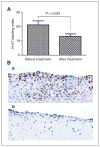Randomized phase II trial of lyophilized strawberries in patients with dysplastic precancerous lesions of the esophagus
- PMID: 22135048
- PMCID: PMC5081263
- DOI: 10.1158/1940-6207.CAPR-11-0469
Randomized phase II trial of lyophilized strawberries in patients with dysplastic precancerous lesions of the esophagus
Abstract
Dysplasia is a histologic precursor of esophageal squamous cell carcinoma (SCC). We previously showed that dietary freeze-dried, or lyophilized, strawberry powder inhibits N-nitrosomethylbenzylamine-induced SCC in the rat esophagus. On the basis of this observation, we conducted a randomized (noncomparative) phase II trial in China to investigate the effects of two doses of freeze-dried strawberries in patients with esophageal dysplastic lesions in a high-risk area for esophageal cancer. We randomly assigned 75 patients identified by endoscopy to have dysplastic esophageal premalignant lesions to receive freeze-dried strawberry powder at either 30 g/d (37 patients) or 60 g/d (38 patients) for six months; the powder was mixed with water and drunk. After six months, we assessed the changes in histologic grade of these lesions (primary endpoint) in a blinded fashion. The dose of 30 g/d, did not significantly affect histology or any other measured parameter. The dose of 60 g/d, however, reduced the histologic grade of dysplastic premalignant lesions in 29 (80.6%) of the 36 patients at this dose who were evaluated for histology (P < 0.0001). The strawberry powder was well tolerated, with no toxic effects or serious adverse events. Strawberries (60 g/d) also reduced protein expression levels of inducible nitric oxide synthase (iNOS) by 79.5% (P < 0.001), cyclooxygenase-2 (COX-2) by 62.9% (P < 0.001), phospho-nuclear factor kappa B (NFκB)-p65 (pNFκB-p65) by 62.6% (P < 0.001), and phospho-S6 (pS6) by 73.2% (P < 0.001). Freeze-dried strawberries (60 g/d) also significantly inhibited the Ki-67 labeling index by 37.9% (P = 0.023). Our present results indicate the potential of freeze-dried strawberry powder for preventing human esophageal cancer, supporting further clinical testing of this natural agent in this setting.
©2011 AACR.
Conflict of interest statement
of Potential Conflicts of Interest Dr. Gary Stoner is part owner of BerriProducts, Inc., a company in Corvallis, Oregon that sells freeze-dried berries including strawberries.
Figures






Comment in
-
Strawberry fields forever?Cancer Prev Res (Phila). 2012 Jan;5(1):30-3. doi: 10.1158/1940-6207.CAPR-11-0534. Cancer Prev Res (Phila). 2012. PMID: 22219164
Similar articles
-
Strawberry fields forever?Cancer Prev Res (Phila). 2012 Jan;5(1):30-3. doi: 10.1158/1940-6207.CAPR-11-0534. Cancer Prev Res (Phila). 2012. PMID: 22219164
-
Protection against esophageal cancer in rodents with lyophilized berries: potential mechanisms.Nutr Cancer. 2006;54(1):33-46. doi: 10.1207/s15327914nc5401_5. Nutr Cancer. 2006. PMID: 16800771 Free PMC article.
-
Inhibition of N-nitrosomethylbenzylamine-induced tumorigenesis in the rat esophagus by dietary freeze-dried strawberries.Carcinogenesis. 2001 Mar;22(3):441-6. doi: 10.1093/carcin/22.3.441. Carcinogenesis. 2001. PMID: 11238184
-
Chemoprevention of esophageal squamous cell carcinoma.Toxicol Appl Pharmacol. 2007 Nov 1;224(3):337-49. doi: 10.1016/j.taap.2007.01.030. Epub 2007 Mar 15. Toxicol Appl Pharmacol. 2007. PMID: 17475300 Free PMC article. Review.
-
Chemoprevention of esophageal squamous cell carcinoma with berries.Top Curr Chem. 2013;329:1-20. doi: 10.1007/128_2012_343. Top Curr Chem. 2013. PMID: 22752584 Review.
Cited by
-
Pediatric Integrative Medicine in Academia: Stanford Children's Experience.Children (Basel). 2018 Dec 12;5(12):168. doi: 10.3390/children5120168. Children (Basel). 2018. PMID: 30545081 Free PMC article. Review.
-
Chemical Compounds of Berry-Derived Polyphenols and Their Effects on Gut Microbiota, Inflammation, and Cancer.Molecules. 2022 May 20;27(10):3286. doi: 10.3390/molecules27103286. Molecules. 2022. PMID: 35630763 Free PMC article. Review.
-
Squamous dysplasia--the precursor lesion for esophageal squamous cell carcinoma.Cancer Epidemiol Biomarkers Prev. 2013 Apr;22(4):540-52. doi: 10.1158/1055-9965.EPI-12-1347. Cancer Epidemiol Biomarkers Prev. 2013. PMID: 23549398 Free PMC article.
-
Protective Role of Dietary Berries in Cancer.Antioxidants (Basel). 2016 Oct 19;5(4):37. doi: 10.3390/antiox5040037. Antioxidants (Basel). 2016. PMID: 27775562 Free PMC article. Review.
-
Chemopreventive Properties of Black Raspberries and Strawberries in Esophageal Cancer Review.Antioxidants (Basel). 2022 Sep 15;11(9):1815. doi: 10.3390/antiox11091815. Antioxidants (Basel). 2022. PMID: 36139889 Free PMC article. Review.
References
-
- Souza RF. Molecular and biologic basis of upper gastrointestinal malignancy–esophageal carcinoma. Surg Oncol Clin N Am. 2002;11:257–72. - PubMed
-
- Layke JC, Lopez PP. Esophageal cancer: a review and update. Am Fam Physician. 2006;73:2187–94. - PubMed
-
- Polednak AP. Trends in survival for both histologic types of esophageal cancer in US surveillance, epidemiology and end results areas. Int J Cancer. 2003;105:98–100. - PubMed
-
- Younes M, Henson DE, Ertan A, Miller CC. Incidence and survival trends of esophageal carcinoma in the United States: racial and gender differences by histological type. Scand J Gastroenterol. 2002;37:1359–65. - PubMed
-
- Brown LM, Devesa SS. Epidemiologic trends in esophageal and gastric cancer in the United States. Surg Oncol Clin N Am. 2002;11:235–56. - PubMed
Publication types
MeSH terms
Substances
Grants and funding
LinkOut - more resources
Full Text Sources
Other Literature Sources
Medical
Research Materials

